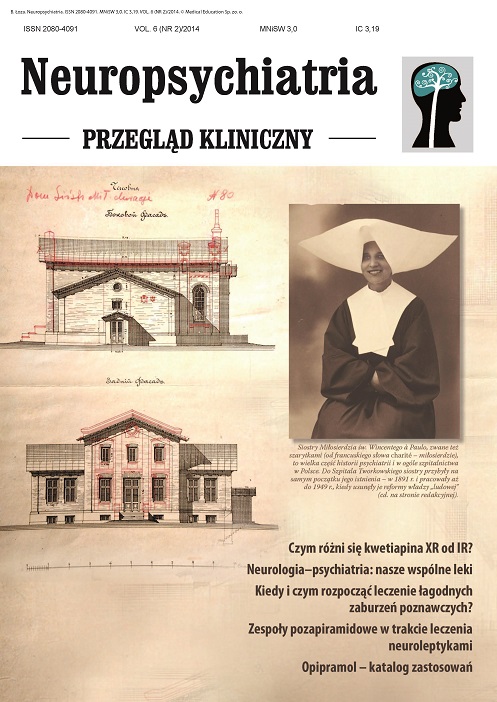16 powodów, dla których warto stosować opipramol Artykuł przeglądowy
##plugins.themes.bootstrap3.article.main##
Abstrakt
Opipramol jest lekiem w pewien sposób wymykającym się klasyfikacjom. Projektowany jako analog imipraminy należy do trójpierścieniowych pochodnych dibenzodiazepiny z podstawowym elementem charakterystycznym dla karbamazepiny oraz łańcucha bocznego, jaki posiadają perfenazyna i flufenazyna. Taka konstrukcja i właściwe dla niej działania kliniczne stawiają opipramol między klasycznymi lekami przeciwdepresyjnymi, neuroleptykami i anksjolitykami [1]. W praktyce klinicznej lek ten nie miał jednak znacznego działania przeciwdepresyjnego, lecz głównie przeciwlękowe, promujące sen i „rozjaśniające nastrój” [2]. To sprawiło, że znalazł on zastosowanie w leczeniu psychogennych zaburzeń czynnościowych, zwłaszcza z objawami wegetatywnymi i narządowymi [3]. Poniżej przedstawiono powody, dla których warto stosować opipramol w praktyce klinicznej.
##plugins.themes.bootstrap3.article.details##

Utwór dostępny jest na licencji Creative Commons Uznanie autorstwa – Użycie niekomercyjne – Bez utworów zależnych 4.0 Międzynarodowe.
Copyright: © Medical Education sp. z o.o. License allowing third parties to copy and redistribute the material in any medium or format and to remix, transform, and build upon the material, provided the original work is properly cited and states its license.
Address reprint requests to: Medical Education, Marcin Kuźma (marcin.kuzma@mededu.pl)
Bibliografia
2. Muller WE, Moller HJ. Opipramol – lek przeciwlękowy i rozjaśniający nastrój (przekład red. Prusiński A). Via Medica, Gdańsk 2003.
3. Holoubek G, Muller WE. Specyfic modulation of sigma binding sites by the anxiolytic drug opipramol. J Neural Transm 2003 Oct; 110 (10): 1169-79.
4. Moller HJ, Volz HP, Reimann I et al. Opipramol for the treatment of generalized anxiety disorder: a placebo controlled trial including an alprazolam – treated group. J Clin Psychopharm 2001; 21: 59-65.
5. Agencja Oceny Technologii Medycznych. Dokumenty rejestracyjne opipramolu.
6. Prusiński A. Opipramol (Pramolan): renesans leku i jego aktualne zastosowanie. Praktyka Medyczna 2003; 46-52.
7. Benca RM, Obermeyer WH, Thisted RA, Gillin JC. Sleep and psychiatric disorders: a meta-analysis. Arch Gen Psych 1992; 46: 651-670.
8. Barbour JA. Psychotropic agent in the climacteric. Practitioner 1972; 209: 369.
9. Prusiński A. Migrena transformowana. Migrena 2000; 1: 9-12.
10. Heuppe M, Hartge D, Stoll KD, Ros A, Schmucker P, Gerlach K. Opipramol improves subjective quality of sleep the night prior to surgery: Confirmatory testing of a double-blind, randomized clinical trial. Neuropsychobiology, 2011 May 14; 64(1): 24-31.

